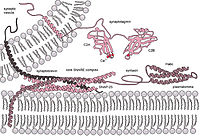
Photo from wikipedia
Untargeted label-free interrogation of proteins in their functional form directly from their physiological environment promises to transform life sciences research by providing unprecedented insight into their transient interactions with other… Click to show full abstract
Untargeted label-free interrogation of proteins in their functional form directly from their physiological environment promises to transform life sciences research by providing unprecedented insight into their transient interactions with other biomolecules and xenobiotics. Native ambient mass spectrometry (NAMS) shows great potential for the structural analysis of endogenous protein assemblies directly from tissues; however, to date, this has been limited to assemblies of low molecular weight (<20 kDa) or very high abundance (hemoglobin tetramer in blood vessels, RidA homotrimer in kidney cortex tissues). The present work constitutes a step change for NAMS of protein assemblies: we demonstrate the detection and identification of a range of intact endogenous protein assemblies with various stoichiometries (dimer, trimer, and tetramer) from a range of tissue types (brain, kidney, liver) by the use of multiple NAMS techniques. Crucially, we demonstrate a greater than twofold increase in accessible molecular weight (up to 145 kDa). In addition, spatial distributions of protein assemblies up to 94 kDa were mapped in brain and kidney by nanospray desorption electrospray ionization (nano-DESI) mass spectrometry imaging.
Journal Title: Analytical Chemistry
Year Published: 2022
Link to full text (if available)
Share on Social Media: Sign Up to like & get
recommendations!